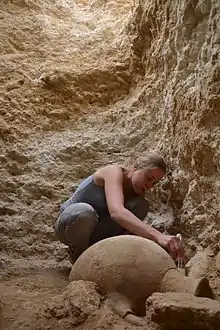Kokkinokremmos
Pyla-Kokkinokremos (Greek: Πυλα-Κοκκινοκρεμος) (red cliff)[1] was a Late Bronze Age settlement on Cyprus, abandoned after a brief occupation.

History
The site of Pyla-Kokkinokremos, located on a rocky plateau, lies about 10 km east of Larnaca, ancient Kition, and some 20 km southwest of Enkomi, two major Bronze Age centres of the 13th-12th c. BC, the period known as Late Cypriot IIC and IIIA.
The site was explored at previous occasions by P. Dikaios in 1952, by V. Karageorghis in 1981-1982 and, more recently, in 2010–2013, by V. Karageorghis and A. Kanta. Since 2014, the excavation is a joint venture between J. Bretschneider (UGhent), J. Driessen (UCLouvain) and A. Kanta (Mediterranean Archaeological Society).
Based on the different explorations, it can be assumed that the entire plateau of ca. seven hectares was densely occupied. Most telling is the excavation of part of a regularly laid-out settlement in the eastern and north-western sector of which the outer perimeter ‘casemate’ wall is assumed to have encircled the entire hill top plateau. The repetition of residential units within the excavated sectors appears to suggest that the establishment of the settlement was a deliberate and planned enterprise. Moreover, the discovery of material culture, including several hidden hoards of precious metals, seems to indicate the planned and organized abandonment of the settlement; since the inhabitants never retrieved these hoards, it is believed they were killed or enslaved. Former excavations have yielded two tablets inscribed in Cypro-Minoan and have confirmed the international character of its material culture, such as Minoan, Canaanite, Mycenaean, Sardinian, Hittite and Cypriot ceramics. The project aims to get a better understanding of the multicultural character of the site, especially against the background of the continuing discussion on migration, interaction and acculturation, which typifies the late 13th and early 12th c. BC in the Eastern Mediterranean.
Pyla-Kokkinokremos was established at a time when the Late Bronze Age collapse reached its zenith, just a few decades prior to its eventual seemingly premeditated abandonment. While the settlement was never reoccupied and has a lifespan of less than fifty years, Pyla becomes a very valuable ‘time capsule’ of the LC IIC-IIIA critical phase. Owing to these facts together with its ethnically amalgamated material, the archaeological data from Pyla-Kokkinokremos surface as an exceptional opportunity to address the Late Bronze Age collapse and international contacts in the Levantine and Eastern Mediterranean world.
References
- Excerpt of wall mounted text in exhibit room number 2 at Larnaca District Museum
Bibliography
Bretschneider J./ Kanta A./ Driessen J., 2018:Pyla-Kokkinokremos (Cyprus) : Preliminary report on the 2015-2016 Campaigns, in: Ugarit-Forschungen. Internationales Jahrbuch für die Altertumskunde Syriens-Palästinas 48, 39-120.
- Bretschneider J./ Kanta A./ Driessen J., 2015: Pyla-Kokkinokremos. Preliminary Report on the 2014 Excavations, in: Ugarit-Forschungen. Internationales Jahrbuch für die Altertumskunde Syriens-Palästinas 46, 1-37.
- Karagheorghis, V. / Kanta, A., 2014: Pyla-Kokkinokremos: A late 13th-century B.C. fortified settlement in Cyprus. Excavations 2010–2011. Studies in Mediterranean Archaeology 141. Uppsala: Åströms Förlag.
- Karagheorghis, V. / Demas M., 1984: Pyla-Kokkinokremos. A late 13th-century B.C. fortified settlement in Cyprus. Nicosia: Department of Antiquities, Cyprus